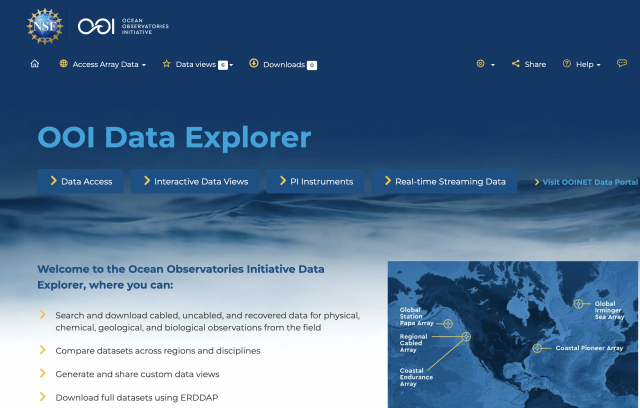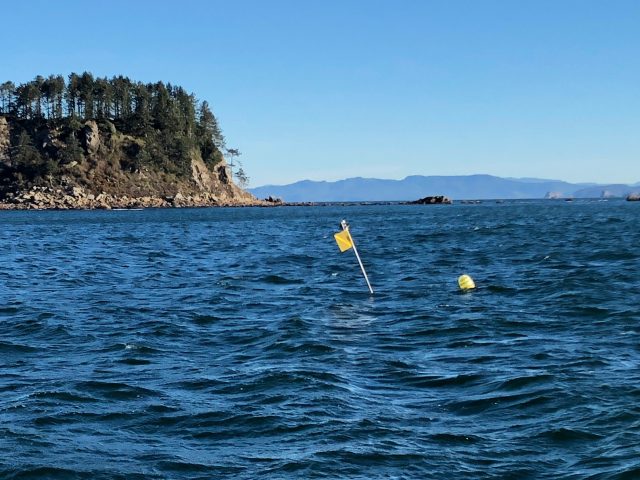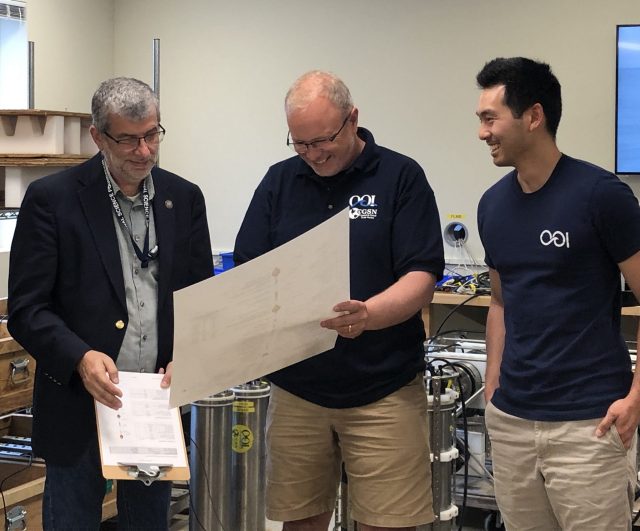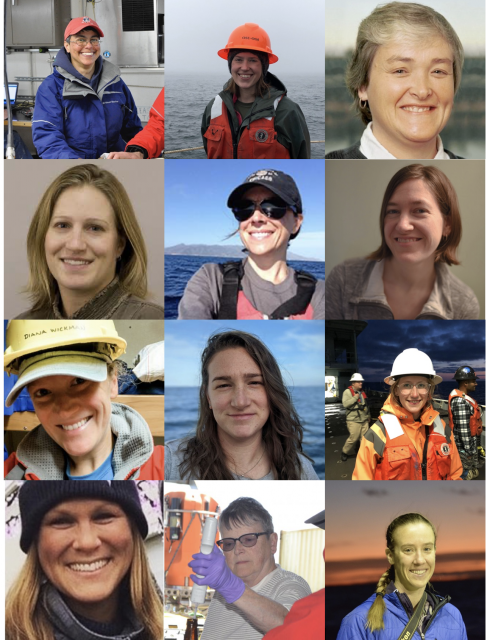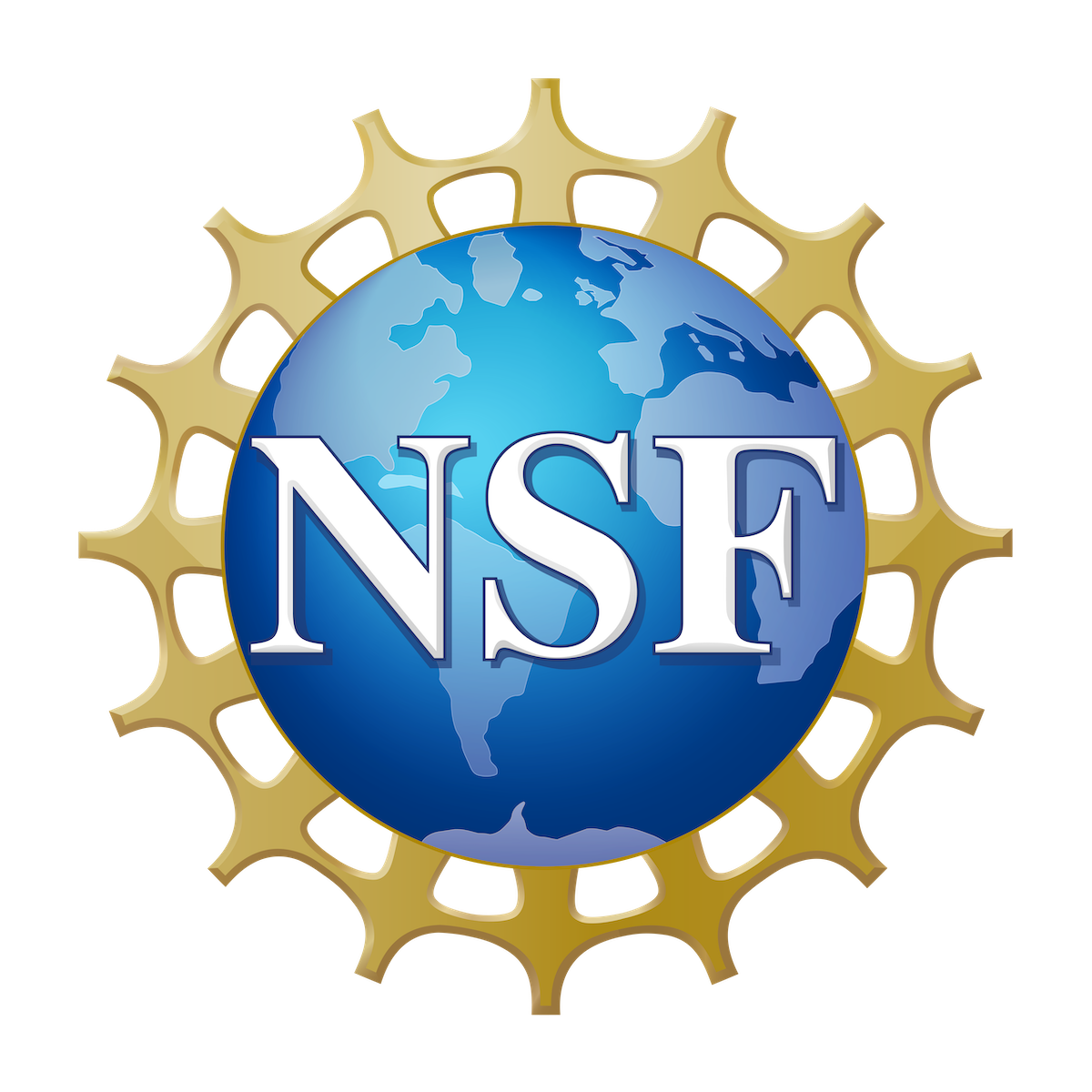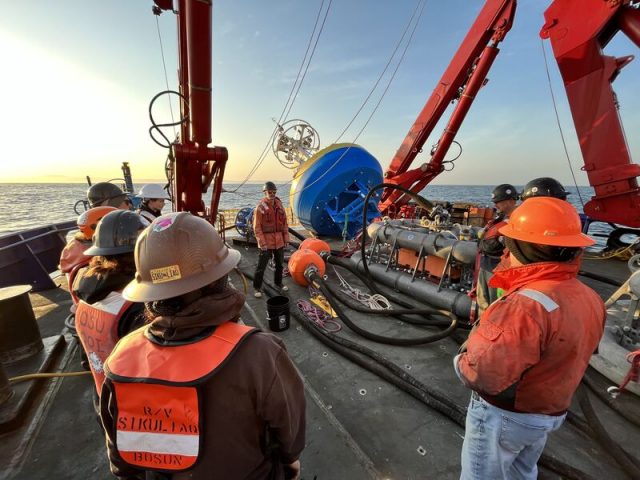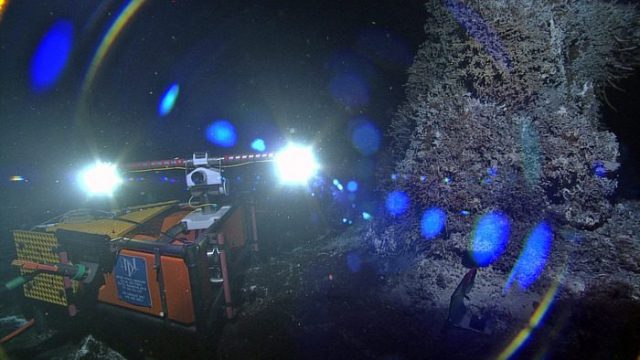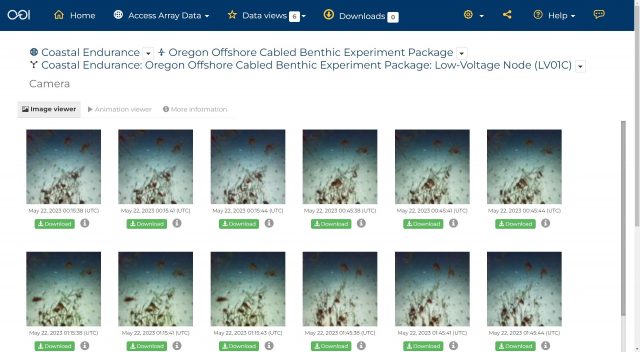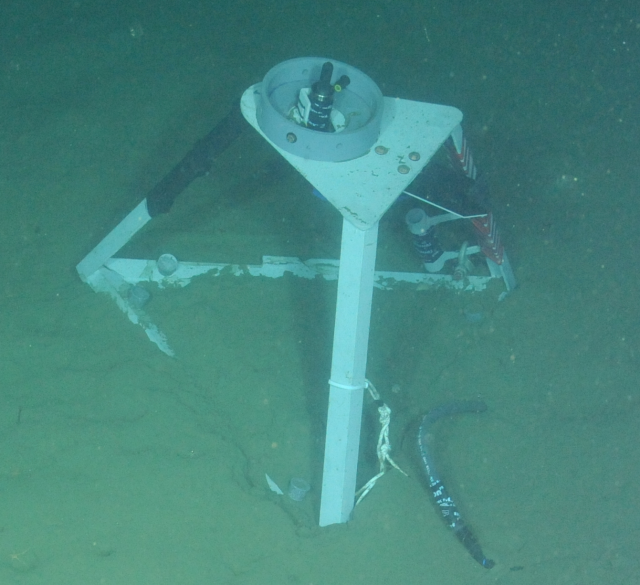Posts by ooistaff
Data Explorer Town Hall July 26 to Demo New Features
Mark your calendars for July 26, 2023 at 1 pm Eastern for an OOI Town Hall to demonstrate the new features of Data Explorer. Register for the Demo Town Hall here.
The latest Data Explorer, version 1.5, includes a significant expansion of data availability, updates to a viewer for underway still images, and introduces a beta version of real-time streaming for cabled instruments. Version 1.5 offers new scientific data for Autonomous Underwater Vehicles (AUV) and Bio-Acoustic Sonar (ZPLS) instruments and Principal Investigator-added instrument data are now available on the site. Visitors to the site will experience optimization and new viewing capabilities for still and animated images. Additionally, data are streamed in real-time by the second for cabled instruments in the Regional Cabled Array, giving users the most up-to-date information available.
Axiom Chief Operating Officer Stacey Buckelew and OOI Senior Manager of OOI Cyberinfrastructure and OOI Data Lead Jeffrey Glatstein will demo the new features and there will plenty of time for questions. For those unable to attend the live demonstration, the demo will be archived and available for viewing at a later date.
The new features were formally launched on May 30,2023. Further details about the new features and launch are available here.
Read More
Collaborative Data Partnership Providing Fuller, More Robust Picture of Conditions in Northeast Pacific
A new data initiative involving more than 20 years of oceanographic data from Olympic Coast National Marine Sanctuary (OCNMS) promises to provide scientists and the public with a more robust picture of changing ocean conditions within the sanctuary and Northeast Pacific Ocean.
Funded by the National Oceanic and Atmospheric Administration’s (NOAA) Climate Program Office, a team from Oregon State University is working to make 23 years of sanctuary mooring data and data from CTD (Conductivity, Temperature, and Depth) casts available through publicly accessible data repositories. The three-year project will also combine the sanctuary’s data with complementary data sets in the region, including data from the Ocean ObservatorIes Initiative (OOI) Coastal Endurance Array.
“The OCNMS data are a critically important data set that has not been fully unlocked and represents a treasure chest of information that we’ve only begun to crack open,” said Jenny Waddell, research coordinator at Olympic Coast National Marine Sanctuary and a collaborator on the project. “The data will provide information about marine heat waves, changes in timing of spring transition to upwelling, seasonal hypoxia, and ocean acidification, all of which will help improve the management of marine resources in the sanctuary.”
Olympic Coast National Marine Sanctuary, along Washington State’s outer coast, represents one of North America’s most productive marine ecosystems. An area of summertime upwelling of cold nutrient-rich waters, the sanctuary hosts a diverse ecosystem that is home to many commercially and culturally important fisheries.
[media-caption path="https://oceanobservatories.org/wp-content/uploads/2023/06/SP_stern_JWaddell_Aug2021.jpeg" link="#"]The stern of the R/V Storm Petrel hints at some of the enhanced capacity that this new vessel brings to research on the Olympic Coast, including a larger work area on the back deck, an upper deck for seabird and mammal surveys, a new pot hauler and knuckle boom crane, and a much more capable A-frame and winch. Credit: Jenny Waddell © NOAA.[/media-caption]Collected by 10 oceanographic moorings, the process of taking 23 years of the sanctuary’s quality-controlled data (water temperature, salinity, density, spiciness, velocity, and dissolved oxygen concentration) and meshing them with data from 700 CTD casts is a huge undertaking that will be conducted in multiple steps. The first step was the handover of all processed and raw data by the sanctuary to data experts Brandy Cervantes and Craig Risien at OSU. The data experts, who are Co-PIs on the NOAA project, are going through all the data and reprocessing where necessary to make sure that all the data are interoperable. The high-resolution CTD data are of particular interest, having never been made widely available before. These data will provide information about the water column to complement and validate the data collected by the instruments on the moorings.
OOI’s Contribution
The Coastal Endurance Array’s Washington Inshore mooring is the shallowest of the three OOI moorings off Washington State and lies just inside the sanctuary’s southern boundary. This location helps provide an in-depth look at ongoing conditions nearer the coast. While the other two Endurance Array moorings off Washington State are farther offshore and to the south, not formally within the sanctuary boundaries, they provide valuable year-round data, which are particularly helpful for context on conditions farther offshore from the sanctuary and for regional forecasting and prediction efforts of ocean conditions. Sanctuary moorings are seasonal, collecting data when they are deployed in May through the first week of October when they are recovered, except for a single overwintering mooring, so OOI data also provide important year-round context for OCNMS.
“Data from the other two Endurance Array moorings not within the sanctuary boundary are equally valuable, not just for prediction purposes, but to our tribal partners. A unique thing about the Olympic Coast National Marine Sanctuary is that nearly the entire sanctuary is within the Usual and Accustomed Fishing Areas of the four coastal treaty tribes in Washington — the Hoh Tribe, Makah Tribe, Quileute Tribe, and the Quinault Indian Nation. The sanctuary and OOI-derived data are particularly valuable to the Quinault Tribe, who use these data to estimate fish runs. They have found, for example, that our oxygen data are a good predictor of the Coho salmon run size in some of the coastal rivers,” Waddell explained.
Olympic Coast Data Applications
Sanctuary data are the foundation of the LiveOcean model, an ongoing project of the University of Washington Coastal Modeling Group that provides short-term (three-day) forecasts of ocean conditions—currents, temperature, salinity and biogeochemical fields such as harmful algal blooms. Sanctuary data also are incorporated in the J-SCOPE model, operated by the Northwest Association of Networked Ocean Observing Systems (NANOOS), for seasonal (six to nine month) forecasts of ocean conditions that are relevant to management decisions for fisheries, protected species, and ecosystem health.
Sanctuary and OOI data also serve as the basis for novel estimates of pre-industrial and near future (2030–2050) ocean acidification conditions on the Olympic Coast led by NOAA Pacific Marine Environmental Laboratory ocean carbon scientists. These estimates are made possible by rich NOAA Ocean Acidification Program-funded coastal observing efforts and inform state and tribal fisheries and water quality management (cf. Alin et al. 2023 in press).
Changing Conditions
“In the 23 years that we’ve been collecting data, we have been documenting changing ocean conditions that are quite alarming,” said Waddell. The 465-page latest Condition Report for the Sanctuary details how ocean conditions along the Olympic Coast continue to change and intensify in response to climate change. The report lays out concerns about the impacts from ocean acidification, warming ocean temperatures, increased stratification, rising sea levels, and declines in dissolved oxygen, in addition to the intermittent occurrences from more intense and frequent marine heatwaves, harmful algal blooms, and coastal storms.
[media-caption path="https://oceanobservatories.org/wp-content/uploads/2023/06/IMG_4898.jpg" link="#"]Oceanographic moorings deployed by Olympic Coast National Marine Sanctuary, such as this mooring near Cape Alava, have been tracking changes in ocean conditions along this remote and rugged coastline for more than two decades. Credit: Jenny Waddell ©NOAA.[/media-caption]To help bring this information to the public, the sanctuary has developed a user-friendly and searchable graphic interface that provides easy access to data within the report. Called the Web Condition Report (WebCR), the interface is designed to connect people with information they are interested in.
[media-caption path="https://oceanobservatories.org/wp-content/uploads/2023/06/OCNMS_O2_plots_5panel_2018-scaled.jpg" link="#"]
This is an example of the type of information available through WebCR. Like animals on land, most marine animal species need oxygen to survive. To obtain oxygen, whales and turtles periodically breathe air at the water’s surface, while most fish species obtain oxygen that is dissolved in seawater. Low oxygen levels can harm marine animals or force them to move to areas with more hospitable conditions. Cape Elizabeth in the south (2006–2017), for example, has gotten progressively worse over time and in recent years is hypoxic 44 percent of the time. Image source: Alin et al., 2023 in prep. Also reprinted from: Office of National Marine Sanctuaries. 2022. Olympic Coast National Marine Sanctuary Condition Report: 2008–2019. U.S. Department of Commerce, National Oceanic and Atmospheric Administration, Office of National Marine Sanctuaries, Silver Spring, MD. 453 pp.[/media-caption] “These 23 years of data now being sorted will help us get a handle on what is really going on in the Pacific Northwest. It’s an important microcosm of what’s happening on a larger scale. Only around 25,000 people live along the Olympic Coast between Neah Bay and Ocean Shores, so the human footprint of this place is minimal. Most of what we’re seeing and what the data are telling us are climate forced issues coming to bear here,” added Waddell. “And having our data in the hands of senior oceanographers who know exactly what to do with it is just so incredibly valuable to understand not only what’s happening at the ocean surface, but within the full water column, which is where most of the impacts of climate change are occurring.”
The Principal Investigator (PI) for this project is College of Earth, Ocean and Atmospheric Science (CEOAS) Oregon State University (OSU) Associate Professor Melanie R. Fewings. Co-principal Investigators are Craig M. Risien, OSU Senior Faculty Research Assistant II and OOI Cyberinfrastructure Project Manager; Co-Principal Investigator Brandy T. Cervantes, OSU Senior Research Associate.
In addition to the PIs and NOAA’s Waddell, other collaborators include Dr. Simone Alin, NOAA Pacific Marine Environmental Laboratory, Katie Wrubel, Resource Protection Specialist, OCNMS, Joe Schumacker, Marine Resources Scientist, Quinault Indian Nation, Dept. of Fisheries, Tommy Moore, Oceanographer, Northwest Indian Fisheries Commission, Charles Seaton, Senior Oceanographer, Columbia River Inter-Tribal Fish Commission, Kym Jacobson, Research Zoologist, NOAA Northwest Fisheries Science Center, Jennifer Fisher, NOAA Cooperative Institute for Marine Ecosystem and Resources Studies, OSU, and Maria Kavanaugh, Assistant Professor, CEOAS, OSU, and Principal Investigator of the Marine Biodiversity Network.
Read More
NSF Large Facilities Team Visits OOI at WHOI
Representatives from the National Science Foundation’s (NSF) Large Facilities Office visited Woods Hole Oceanographic Institution (WHOI) on Monday June 26-Tuesday June 27 to get a first-hand look at the various facilities at WHOI supported by the NSF. The visit kicked off at LOSOS on the Quissett Campus with a discussion of the Ocean Observatories Initiative (OOI), followed by a tour of its facilities.
OOI’s program office (PMO) is located at WHOI and led by Principle Investigator Jim Edson. On Monday morning, Edson welcomed the NSF visitors, introduced the PMO team, and provided an overview of OOI’s organization, operations, and how scientists are using its data to expand understanding of ocean processes and conditions. OOI Senior Program Manager Paul Matthias followed with a technical presentation of how this large and complex program is managed, kept on budget with continuous collection and disseminating of OOI data.
[media-caption path="https://oceanobservatories.org/wp-content/uploads/2023/06/IMG_1148-2-scaled.jpg" link="#"]WHOI Assistant Scientist Hilde Oliver gave a lightning talk on how she used OOI data to explain the role of wind in ephemeral surface chlorophyll enhancement at the New England Shelf Break. [/media-caption]A Q&A session was held over lunch. The afternoon session commenced with virtual presentations by the OOI Data Center at Oregon State University, followed by a review of major components, organization, and operations of three OOI components – Coastal Endurance Array at Oregon State University, Coastal and Global Scale Nodes at WHOI, and the Regional Cabled Array at the University of Washington. A tour of LOSOS followed the presentations.
[media-caption path="https://oceanobservatories.org/wp-content/uploads/2023/06/IMG_1163-scaled.jpg" link="#"]OOI Instrumentation Lead Jennifer Batryn took apart an Acoustic Doppler Current Profiler (ADCP) during a tour of the LOSOS electronics lab during an NSF visit. [/media-caption]The NSF visitors attending the daylong session focused on OOI were Linnea Avallone, Chief Officer for NSF Research Facilities, Jim McManus, Director Division of Ocean Sciences, and George Voulgaris, OOI Program Manager. Rose Dufour, Program Director Ship Operations, joined the group for a tour of the OOI facilities in LOSOS.
“We were delighted to have the opportunity to show off the technically advanced and rugged OOI ocean observing equipment and the amazing talents of the team who designs, builds, maintains, and keeps this equipment operating in difficult conditions to our NSF colleagues,” said Jim Edson, Lead PI of OOI’s Program Office. “Seeing the size and scope of the equipment firsthand gives one a real understanding of the complexity of OOI operations and the importance of the data being collected and integrated into research.”
The NSF visitors returned to WHOI on Tuesday morning to visit and learn more about other NSF-sponsored programs at WHOI, including a visit to the National Deep Submergence Facility, ship operations, the Northeast U.S. Shelf (NES) Long-Term Ecological Research (LTER) project, and the Center for Chemical Currencies of a Microbial Planet.
OOI Program Director George Voulgaris spent the second day of his visit to WHOI with members of OOI’s Program Office and the Coastal and Global Scale Nodes (CGSN) team. On Tuesday, CGSN members showed off their northern LOSOS facility, where they were burning in equipment for deployment at the Global Irminger Sea Array this summer and testing two Autonomous Underwater Vehicles (AUV) prior to deployment. The visit ended with a pizza lunch that provided Voulgaris an opportunity to meet all members of the CGSN team and learn more about their individual roles and responsibilities.
[media-caption path="https://oceanobservatories.org/wp-content/uploads/2023/06/IMG_1168-scaled.jpg" link="#"]George Voulgaris, OOI Program Manager (left) discusses mooring issues with OOI Senior Program Manager Paul Matthias, and OOI Lead Jim Edson during a tour of the LOSOS outdoor facility, where segments of OOI moorings are stored prior to mobilization. [/media-caption] [media-caption path="https://oceanobservatories.org/wp-content/uploads/2023/06/IMG_1172-scaled.jpg" link="#"]OOI Coastal and Global Scale Nodes Project Manager Derek Buffitt explains the components that comprise the Multi-Function Node, which holds the anchor and instrumentation near the bottom of the OOI arrays, to Linnea Avallone, Chief Officer for NSF Research Facilities during a tour of OOI LOSOS. [/media-caption] [media-caption path="https://oceanobservatories.org/wp-content/uploads/2023/06/IMG_1197-scaled.jpg" link="#"]OOI Glider Lead Peter Brickley explains the operation of the tail fin and air bladder of an OOI glider to NSF OOI Program Director George Voulgaris. [/media-caption] [media-caption path="https://oceanobservatories.org/wp-content/uploads/2023/06/IMG_1226-scaled.jpg" link="#"]NSF OOI Program Director George Voulgaris (left) reviews the components of a global surface mooring with OOI Senior Engineer John Lund and Research Engineer James Kuo. [/media-caption] [media-caption path="https://oceanobservatories.org/wp-content/uploads/2023/06/IMG_1235-scaled.jpg" link="#"]Glider Lead Peter Brickley explains the operations of the Autonomous Underwater Vehicle (AUV), REMUS to NSF OOI Program Director George Voulgaris. Diana Wickman, left rear, who keeps the AUVs operational was on hand for the presentation and to answer questions about the vehicle’s operations, as well. [/media-caption]Photos taken by Darlene Trew Crist © WHOI.
Read More
Celebrating OOI Women for International Women in Engineering Day
International Women in Engineering Day is a time to celebrate women. We are grateful to the many women (a sampling of whom appear in the pic below) who contribute to OOI, helping to advance understanding of the changing ocean. Thank you all for everything you do to make OOI able to provide critical ocean data, day after day, year after year, for everyone who is interested in learning more about how the ocean works. #inwed23
Read MorePI-Added Sensors / Equipment Requests for Pioneer Array MAB Accepted After Array is Operational
We are very excited about deploying the Pioneer Array in its new location in the southern Mid-Atlantic Bight (MAB), including new designs and new sensors. The MAB location and design require new permitting, new engineering, and inclusion of new sensors as part of the core Array measurements. We are optimistic that we are on track to deploy the new Array in Spring 2024 as planned.
Because of this aggressive timeline for deployment in the new location, the National Science Foundation (NSF) has directed the OOI Facility to put acceptance and evaluation of Principal Investigator requests for new sensors/equipment on hold until the new Array has been deployed and fully operational for one month. This will allow the OOI to focus on delivery of the core OOI measurements during this critical period, including initial understanding of performance. The NSF also has directed the OOI to return assessments as soon as practicable after the hiatus has been lifted, ideally by Summer 2024.
Specific dates will be posted as they become known. Regular updates on progress at the Pioneer Array MAB will be posted here.
Read MoreGraduate Student Opportunity Aboard Fall Endurance Expedition
Under the UNOLS Cruise Opportunity Program, there are two openings for student volunteers for the Fall 2023 Deployment Operations Ocean Observatories Initiative (OOI) Endurance Array expedition. This cruise aboard the R/V Atlantis leaves from Astoria, OR on September 19th, with loading on September 17th and September 18th, returning to Newport, OR on October 6th. The ship will be unloaded on October 7th. The cruise will consist of two or more several-day long legs, with one day in port in between legs. Unload will happen on October 7th. The opportunity is open to students that are U.S. based and able to travel to Oregon. Interested students should apply to opportunities@unols.org by July 15th, 2023. Travel funds may be available for the selected participants.
Further details can be found here.
A day in the life aboard the R/V Sikuliaq.
[video width="480" height="848" mp4="https://oceanobservatories.org/wp-content/uploads/2023/04/March-18-aboard-VIDEO-2023-03-24-01-25-52.mp4"][/video]Hear from UNOLS student volunteer Olana Costa about her experience during Endurance 18:
[video width="848" height="480" mp4="https://oceanobservatories.org/wp-content/uploads/2023/03/Olana-Costa-UNOLS-volunteer-2023-03-16-12-34-53.mp4"][/video] Read More.MOV Files to be Archived at Beginning of 2024
High resolution .MOV files from the Regional Cabled Array’s (RCA) high-definition video camera older than a year will be transferred to a deep archive beginning January 2024. More recent .MOV files up to a year old will remain available for immediate download from the raw data server, while the same files in the smaller .MP4 file format will always be available the raw data server. Once archived, the .MOV files will remain accessible via a request rather than a simple download.
Daily live video streams from the RCA’s camera document the active hydrothermal vent called “Mushroom” in the ASHES hydrothermal field atop Axial Seamount. Scientists are using recordings of the HD video to examine the evolution of the chimney, concomitant changes in the rich biological community that it hosts, and the flow of fluids out of the chimney over time.
[media-caption path="https://oceanobservatories.org/wp-content/uploads/2023/05/J1262_20200806145917_CAMHD-copy.jpg" link="#"]The high definition camera lights up the Mushroom hydrothermal edifice. Credit: UW/NSF-OOI/WHOI. V20.[/media-caption]The .MOV archiving plan is part of an overall plan to store OOI data efficiently and securely to ensure that OOI data users have access to both near real-time and historical data. The plan is important as OOI will eventually need to store and distribute 30 years of data.
“This is really a behind-the-scenes housekeeping issue for most of our data users. But for those interested in having the historical .MOV files readily on hand, we are encouraging them to download footage over the next seven months” explained Craig Risien, Project Manager for the OOI Data Center. “The plan is to archive .MOV files older than one year on a rolling monthly basis. The .MP4 versions of the .MOV files will always be highly available so people will still be able to view and download the footage, they just won’t have instant access to archived high resolution .MOV files.”
For now, users can directly download the .MOV files. Once the archiving process is initiated at the beginning of 2024, a process will be in place to request the archived files.
“We want to give people a long lead time regarding this change so they have adequate time to download whatever .MOV footage they need,” added Risien. “We will have more information about the archiving process as the implementation date draws nearer.”
Read More
Latest Version of Data Explorer Launched May 30
OOI’s Data Science Team, working with Axiom Data Science, announced additional improvements to OOI’s data access and visualization tool, Data Explorer will publicly launch on May 30, 2023. The latest Data Explorer, version 1.5, includes a significant expansion of data availability, updates to a viewer for underway still images, and introduces a beta version of real-time streaming for cabled instruments. Version 1.5 offers new scientific data for Autonomous Underwater Vehicles (AUV) and Bio-Acoustic Sonar (ZPLS) instruments and Principal Investigator-added instrument data are now available on the site. Visitors to the site will experience optimization and new viewing capabilities for still and animated images. Additionally, data are streamed in real-time by the second for cabled instruments in the Regional Cabled Array, giving users the most up-to-date information available.
“A great deal of effort goes on behind-the-scenes to make Data Explorer be responsive to users’ needs and provide seamless, quick access to data,” explained Jeffrey Glatstein, Senior Manager of Cyberinfrastructure and OOI Data Delivery Lead at Woods Hole Oceanographic Institution. “We are grateful to our team and the developers at Axiom who continually make this already great tool, even better.”
Details about the new features are included in the following:
New Features
ZPLS instrument data will now be online for more locations, including the Coastal (Endurance) and Global Arrays (Argentine Basin). This is the first time this type of OOI bioacoustics sonar data have been available in an interactive visualization. This version addressed feedback received from subject matter experts to improve the data charts, including respecting time selections among sonar frequencies, changing variable names, and addresses frequency sorting. Other technical fixes have been made to the backend in response to users’ suggestions, which will help make these data more accessible.
[media-caption path="https://oceanobservatories.org/wp-content/uploads/2023/05/1_1.5_zpls.jpg" link="#"]An example echogram from the bioacoustics sonar instrument on the Coastal Endurance array. The bio-acoustic sonar measures acoustic signals of plankton and zooplankton using sound waves which bounce off organisms back towards the sensor in a phenomenon known as “backscatter.”[/media-caption] [media-caption path="https://oceanobservatories.org/wp-content/uploads/2023/05/2_1.5_auv.jpg" link="#"]An example of interactive AUV data at the Coastal Pioneer Array in the Data Explorer. The travel trajectory of the AUV across the shelf-break is shown in the map. Data collected by the instrument as it dives from the sea surface to a maximum depth of 600m is shown in the chart on the right. Users can visualize data in 3-D across the water column in the lower interactive chart.[/media-caption]A media server will now be up and running on Data Explorer. In this version, updates have been made to improve the performance of the still image viewer. All image collections are shown in a Grid view which makes seeing what is available easier. Camera metadata is now available via a more information tab. Images will also be available on the pages included in time series. Images will also be available as a single image or in animation viewer. Full size images are presented with an image scale and available for download.
[media-caption path="https://oceanobservatories.org/wp-content/uploads/2023/05/3_1.5_image-viewer.jpg" link="#"]Cameras are attached to instruments on the cabled infrastructure of the OOI Regional Cabled Array. These long-term imagery records are now available in the Data Explorer for viewing and download to help understand life in deep water and coastal environments. The camera at Endurance Offshore is designed to look at the seafloor in general, observing animal activity, sediment transport, detritus falls, and bioturbation.[/media-caption] [media-caption path="https://oceanobservatories.org/wp-content/uploads/2023/05/4_1.5_image-viewer.jpg" link="#"]The media viewer in the Data Explorer allows users to pan and expand images, select images across a timeseries, view camera metadata, download images, and animate images across time.[/media-caption]Another added beta media feature is real-time streaming of Cabled Array instrument data. The design of this function is meant to be user-friendly. A Grid view shows available real-time streaming instruments. A Single view shows a real-time streaming chart, with data from the last 24 hours. These features are available from Data Explorer’s landing page with further explanations of what data are available and when.
Added Glatstein, “We invite all OOI data users to try out these new components and continue to provide us feedback. We are particularly eager to hear the community’s response to the beta version of the media server so we can tweak that as needed.”
[media-caption path="https://oceanobservatories.org/wp-content/uploads/2023/05/5_1.5_real-time.jpg" link="#"]An example of real-time streaming data now available for instruments on the Regional Cabled Array. This network of >100 cabled instruments and instrumented moorings transmit data to shore in real-time via fiber optic technology. Users can view and interact with new data every second as it is streamed from the deep ocean to shore.[/media-caption]
Read More
Update on RCA Broadband Hydrophone Data Availability, File Formats, and Directory Structure
As part of continuing OOI data process improvements, the RCA Data and OOI Software Development Teams have been working closely to expand data availability and improve data file consistency for six Broadband Hydrophones (HYDBBs) located at Axial Base (2), Slope Base (2), and Oregon Offshore (1) and Shelf (1) sites. Additional details are available on these study sites and instruments at these links.
A system update will go live at 17:00 UTC June 7, 2023 and will affect all HYDBB data posted on the Raw Data Archive server after that date. In the near future, the updates will also be applied to historical HYDBB files previously posted on the Raw Data.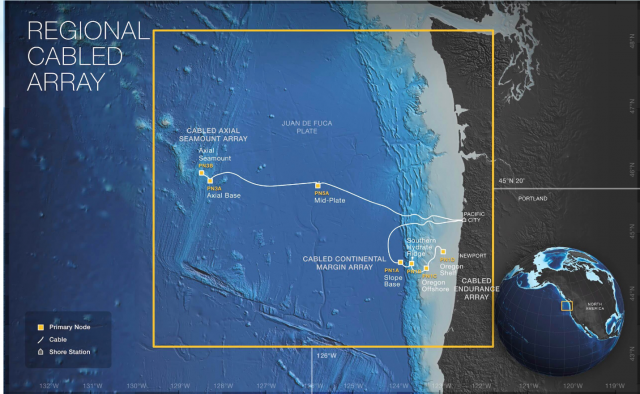
OOI HYDBB data are currently provided to the public on the OOI Raw Data Archive server as MiniSEED-formatted files (extension “.mseed”). This lossless, compressed format is a subset of the Standard for the Exchange of Earthquake Data (SEED) that is in extensive use for archiving and serving seismological data (see IRIS). The HYDBB MiniSEED files are served on the Raw Data Archive in daily subdirectories organized by year and month for each of the sites:
- Axial Seamount – Axial Base
- Continental Margin – Slope Base
- Continental Margin – Oregon Offshore
- Continental Margin – Oregon Shelf
Once the system update goes live on June 7, all HYDBB data posted on the Raw Data Archive server after this date will have the following enhancements:
- Currently, only HYDBB data arriving at the OOI data repository in near real-time are provided to the public in the daily subdirectories, updated at nominal 5-min intervals. After the system update, data arriving at the OOI repository after Navy review will also be made available on the Raw Data Archive. These delayed and previously publicly unavailable data will be provided as analogously named MiniSEED datafiles but in separate subdirectories named “addendum” under each daily directory.
- Each individual MiniSEED file will include HYDBB data over fixed 5 min timespans, starting at 00:00 UTC and repeated at subsequent 5 min intervals (beginning at 00:05, 00:10 UTC, etc.). If no data are available for a specific 5 min timespan, the datafile will not be created. Any gaps in the data stream during each 5 min timespan are accounted for by the use of the multi-trace extension of the MiniSEED file format construct, which allows multiple temporal segments within a single file. Previously, each HYDBB file on the Raw Data Archive contained only a single continuous trace of data. An example Python toolbox for accessing/processing such MiniSEED data is available, with additional information on the ObsPy open-source project here.
This change in file construction will allow for more efficient access and delivery of HYDBB data, particularly when there are small and frequent gaps in the data streams which can lead to excessive file fragmentation, as was often the case with these data before this system update.
If you have any questions, please contact the OOI HelpDesk or post your question on the public OOI Discourse Forum.
Read More
OOI Data to be Archived by NOAA’s National Centers for Environmental Information
NOAA’s National Centers for Environmental Information (NCEI) and the Woods Hole Oceanographic Institution (WHOI) established a Cooperative Research and Development Agreement (CRADA) to share high-quality oceanic data collected from the National Science Foundation (NSF)-funded Ocean Observatories Initiative’s instrument arrays. The goal of the partnership is to archive and deliver the initiative’s data for continued research on ocean processes.
“WHOI is pleased to be working with NCEI for the long-term preservation of data produced by the Ocean Observatories Initiative” said Jeffrey Glatstein, Senior Manager of Cyberinfrastructure at WHOI. “The initiative is a science-driven ocean observing network that delivers real-time data from more than 900 instruments to address critical science questions regarding the world’s oceans. Given the long-term timeframe of the program and the impact of having a continual record of measurements, the archiving of this data is a significant step in making these data available for researchers in the future.”
“Under this partnership agreement, NOAA expects to be provided at least 30 years of high-quality oceanographic data produced by the Ocean Observatories Initiative, commissioned in 2017, for preservation and stewardship” said Jason Cooper, NCEI’s Archivist.
NCEI will be responsible for acquiring and managing the required IT storage for the data that WHOI will provide, which is expected to amount to roughly seven terabytes. NCEI will ensure that the metadata associated with the data are up to federal and international standards such as those regarding storage, preservation, and accessibility. In addition to providing the data that have been collected to date, the agreement also calls for WHOI to transfer an additional 710 gigabytes of data annually for the next ten years.
WHOI is an independent, non-profit organization dedicated to ocean research, exploration, and education. WHOI and their Oregon State University (OSU) and University of Washington (UW) partners designed and now manage the instrument arrays involved in this CRADA partnership that collect chemical, biological, geophysical, and physical measurements in the global ocean from below the seafloor to the surface.
The CRADA allows NCEI and WHOI to achieve their common goal of supporting research related to ocean and atmospheric processes by sharing their findings with the scientific community, policymakers, and the general public.
Read More

